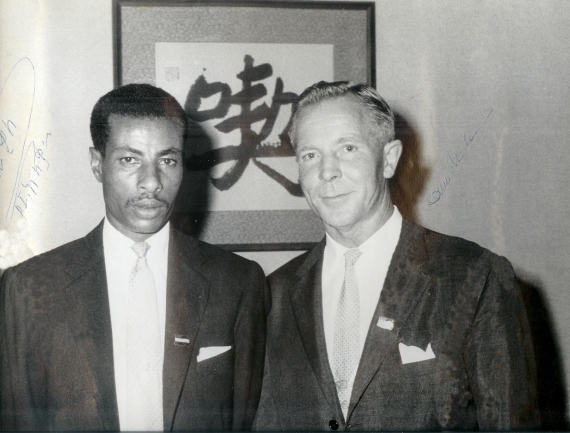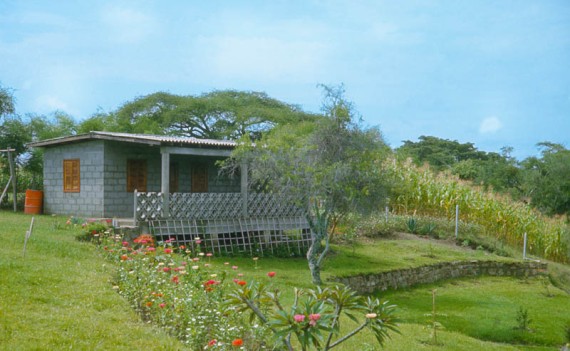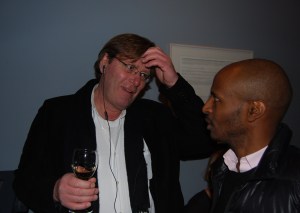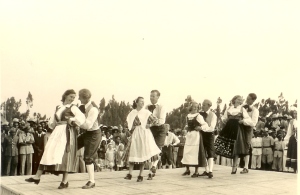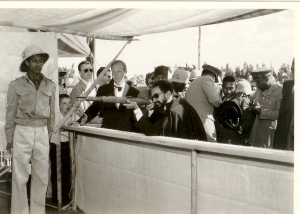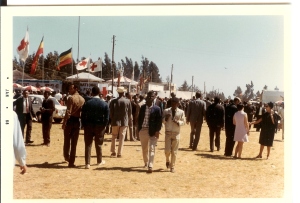Archive for December, 2012
The Dream Of Awassa
!971 when we were in Ethiopia Onni took us to Awassa. He had bought about 8000 square meters of land there that went down the whole way to the water. What a loveley place!
Onni had together with his brothers Arne and Erik decided to build a three family house there were they all could live together when they got older.
My father, Erik, made a drawing for the main house and both of my parents where quite exciting about moving to Ethiopia and so were Arne and his wife Karin too.
One year later they started to build a guest house, drilled a well and a septic tank and put up fence around the whole land.
There was also a cave on the sloop that they planned to make a wine cellar of.
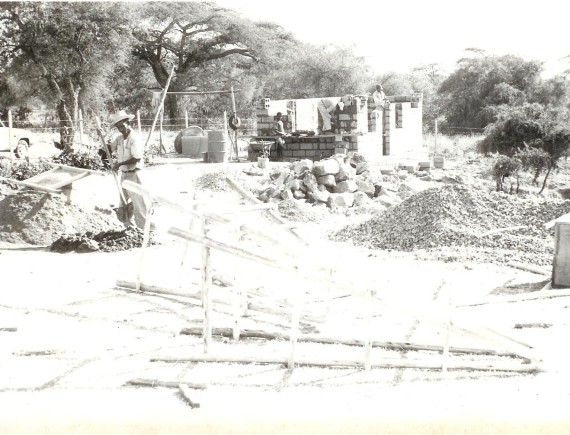
I can still remember how my mother and father planned and talked about this and how much it meant for them to move to Ethiopia and live together there with Onni, Arne and Karin.
1972 went my parents to Ethiopia again to plan everything together with Onni, this was their dream…
Then come the revolution and everything was suddenly very insecure and nobody knew what would happen.
The military even come to Onni because they believed that he had used the cave as a hidding-place for weapons. I think Onni was quite surprised of that himself, he that only cared about people and not about politics at all. The dream was gone and it all come to nothing.
Christmas
Onni was Father Christmas at the Emperor´s Christmas party every year. He could come in a balloon, by donkey, or in a wagon. One year he popped out of a giant cake that his brother Arne had made.
Erik Niskanen decorating Santa´s wagon 1971
Christmas party at the palace. Björn Lundmark, Onni´s “right hand” at A.L.E.R.T. took this piciture with a camera hidden inside the Santa Claus dress.
Onnis Photo album 1
This photo album was collecting dust at the “Swedish save The Childrens” office in Addis Ababa from Onni´s death 1984 until 2010 when Håkan Pohlstrand from the Swedish-Ethiopian Society helped me to return it to Sweden after I had tried for three years…Thank you Håkan!
There are over two hundred images inside and I will share them with you by and by.
One difficult thing with this album is that there are no names or dates anywhere but this is Karl-Gustav Forsmark, one of Onni´s close friends.
How to train Olympic winners
From Duvbo IK’s Annual Magazine 1960
Onni Niskanen tells the story about the marathon winner in Rome.
How to train Olympic winners.
Abebe Bikila, the Ethiopian soldier at the Imperial Life Guards, who won the XVII Olympic marathon race, was the biggest sensation during the Rome Olympics, according to many people. Not even backed, except by me, he ran a race that astounded most people and stepped from Ethiopian local competitions straight into the world élite. Not only did he erase Emil Zatopek’s Olympic record from Helsinki by 8.47 minutes, but also the Russian Popov’s “phantom time” of 2..15,17,0 was erased by the unbelievably great running Abebe.
If needed, Bikila could have pressed the time even more. He put in the real spurt only some km from the finish, when he passed the Obelisk of Axum, an Italian war trophy that they had transported from Ethiopia, with great difficulties, during the Italian occupation.
If it had not been for a small misunderstanding in planning, the record time would most certainly have been even lower. Before the race, I had very carefully drummed the starting numbers of the 5 – 6 best competitors into the head of my two runners, Abebe Bikila and Abebe Wakjira. This was to let them know where the “big guns” were during the race. They were Popov, Rhadi, O’Gorman, Magee, Vorobiev, and a few others, whom I expected would be in the first lot during the race. After a lot of repetitions, my boys knew these starting numbers by heart. However, it turned out that Rhadi had not got his starting number according to the programme, but got permission to use the same number he had in the 10.000 metres race. That confused Abebe Bikila. Morocco had three men in the marathon and Abebe did not understand that it was Radhi, who ran together with him for the main part of the race. He thought that it was one of the other Moroccans keeping up with him, so he was waiting for Radhi to show up further on. Therefore, he saved his strength the last five kilometres and did not run faster than necessary. He was prepared to put in an extra effort if the Moroccan hot favourite Radhi showed up.
The Italian doctor, who examined Abebe after the race, had only one word to say: “Fantastico!” His pulse was 88, his eyes bright, no signs of tiredness and not one blister on his bare feet. On my question, how far he could have continued at the same pace, Abebe answered: 10 – 15 km “ganano” (longer).

(Onni Niskanen, Abebe Bikila, unknown, Arne Niskanen)
That Abebe Bikila won was not a surprise to me. I had pre-warned some newspaper reporters, but most of them did not dare to believe my tip-off. A Danish newspaper and the Finnish “Huvudstadsbladet” had an article about the race winner that I tipped them about, a couple of days before the race.
About the training and the preparations for the race? Well, first, I would like to say that I have not often worked with a better athlete student. He has strong willpower and willingness to train. He has been into sports for a couple of years, played basketball and run 5.000 and 10.000 metres a few times. In this year’s Military Championship Games, he came second in the marathon race, with the time 2 hours 37 minutes, which was his personal best when I took him on for special training.
We then started a training focused on the Olympic Games. All candidates for the Olympic Games had special training programmes and they could show their form at continuous weekly competitions. During the last two months before the Olympic Games, the best of them were in a training camp, where it was tough training with two training sessions per day.
I noticed, at an early stage, that the long distance runners were the ones with the best possibilities and I concentrated especially on their training. As for the sprinters, I had an American, Leroy Walker, to help me with the training. Two Ethiopian instructors, educated at GCI (The Gymnastics Central Institute) in Sweden, also worked focused on the sprinters and the mid-distance runners.
Cross-country running sessions of 1 to 1½ hours were part of the daily training for the long distance runners, but not some casual jogging. Pace training, pace training and more pace training. Speed running for 4-500 metres at highest speed, up rather steep slopes, varied with a bit slower running in between.
The same thing when it came to track training. Pace! Six to eight 1.500 metres races, to start with in 4minutes 20 to 25, then they had to press the times downwards. They also ran on the track for 30 – 40 minutes, with varied pace. Sometime full speed through the bends, sometimes on the straights. Road running was done twice per week and on distances that were increased day by day. Sauna baths twice a week was included in the training, as well as massage after the road running.
Below are the results and times for the marathon runners’ road training.
18/6 20 km no timing
23/6 25 km no timing
28/6 32 km in 1.45,00 (3.13 min/km)
30/6 32 km in 1..46,30 (3.16 min/km)
8/7 36 km in 2.00,45 (3.32 min/km) uphill a lot
25/7 42 km in 2.21,23 (3.21 min/km) selection for Olympic Games, uphill a lot
5/8 32 km in 1.42,16 (3.10 min/km)
20/8 20 km in 1.02,15 (3.07 min/km) in Rome
26/8 20 km in 1.01,30 (3.05 min/km) in Rome
30/8 20 km in 1.01,45 (3.05 min/km) in Rome
4/9 20 km in 1.01,05 (3.03 min/km) in Rome
10/9 42.195 km (the marathon race) in 2.15,16,2 (3.12,4 min/km)
During the month before race day, when we were in Rome, my two marathon runners ran parts of the marathon track 4 – 5 times, 20 km every time. Sometimes they ran the first part of the track, later the middle part and a couple of times the last 20 kilometres. This way they came to knew the whole track, all the difficulties and they did not have to hesitate about the where the track went.
I let them run alternately with or without shoes. I myself followed behind Abebe Bikila by car and studied style, foot stance and counted step speed. My brother Arne was in another car and studied Abebe Wakjira, who was always behind from the beginning. It appeared that Abebe Bikila was 5 – 6 steps slower per minute with shoes and his running style was not as perfect as when he ran barefoot.
After a few similar trials, we decided to let both of them run barefoot in the marathon race. The race took place in the evening, so the risk of hot tarmac was completely gone. After the decision, the runners ran barefoot all the time to harden the soles of their feet. Even in the Olympic Village, they had to walk around without shoes.
Up until three days before the race, both runners trained daily. In the early stage, they trained twice per day, but during the last week, it was cut down to one training session per day, alternatively in the stadium, cross-country or on the marathon track.
During the training period in Rome, I often added speed training. They ran 400 and 1.500 metres races, with a couple of minutes rest between each race, and 5.000 metres a couple of times. Abebe Bikila did 14.36 on 5.000 metres barefoot, without exhausting himself. That is not bad for a marathon runner!
On the race day, Abebe Bikila had orders to take it rather easy the first 25 kilometres and, if you look at the times in this world leading marathon race, you can see that he followed the instructions to the letter. Below are the official intermediate times of the race.
5 km 15,35 min = 15,35
10 km 31,07 min = 15,32
15 km 48,02 min = 16,55
20 km 1.02,39 hrs = 14,37
25 km 1.20,47 hrs = 14,08
30 km 1.34,29 hrs = 15,58
35 km 1.50,27 hrs = 7,31
42,195 km 2.15,16,2 = 17,18
Most of the hot favourites were left behind, due to the high speed between 20 and 30 kilometres. Radhi was the only one who could keep up, but the speed was too much even for him. That was obvious as he let go immediately when Abebe Bikila put in a spurt on the last kilometres. He never stood a chance!
After the race, I asked the happy triumphant victor how he felt when Radhi (who he did not know it was) started to drop behind. “When I sped up, inside the city wall, I heard less and less of the clattering footsteps behind me”, said Abebe, “and when I increased the speed more, they disappeared. It was not necessary to turn around and look”, he continued, “for if you have heard these footsteps behind you during a whole hour, then you know what it means when they fade away. I was happy. I did not fear a spurt fight, but it felt good to get rid of the stubborn Moroccan. And thank you, Major Onni, for what you have done!”
I was overjoyed by Abebe Bikila’s victory, which means so much to my continuous work within sports in Ethiopia, but I must say that my joy was just as big for Abebe Wakjira’s seventh place. He is 39 years old and before we left Addis, he had 2.30,26 as his best time at marathon, which by all means is not bad, and with that time, he was second after Abebe Bikila in the qualifying race. Some people thought it unnecessary to take him with us to Rome, but I protested and insisted that he had not finished his training. “Give me another month and you will see that he will improve. He is old and needs longer time to get in shape”, I said. During the training period in Rome his form chart rose, as I had predicted, and when the marathon race went off, he was at the top of his capacity. He had always had problems keeping up with fast speed in the beginning, contrary to Abebe Bikila, and he took it easy in the Rome race as well. Maybe a bit too easy! He gradually advanced towards the lead and passed several of the favourites. He also had plenty of power left after the race and confessed that he probably had been too cautious the first 20 kilometres.
Unfortunately, I had to leave two of my best runners at home, due to illness. One marathon runner, who in fact was the one who won the military championship marathon race last spring when Abebe Bikila came second, and a very good 10.000 metres runner. The marathon runner, Besha Teklu, would certainly not have done as well as Abebe Bikila, but he was considerably better than the 7th placed Wakjira.
I have to tell a story about the 10.000 metres runner. He was ready for Rome. One day, when we were at the training camp, all of them had to go in to Addis for fitting of the Olympic costume. They got bus fare for the 50 km long trip and all was well. A few days after, Wami Berede, the best 10.000 metres runner, came down with a severe cold that kept him in bed for over a week. That was really bad luck and meant that one of my trump cards was gone. Some time later I heard that, instead of taking the bus in to Addis for the fitting of the costume, he had run the whole way there and back, 100 kilometres! He had done it with the best of intentions and, as he thought, by this 100 km run, train his stamina even more. Instead, he ruined his chances. The training programme I had set up was very tough itself and to run 100 km in one day, Saturday, when according to the programme he should take it easier than weekdays, was pure madness. It was probably also the cause of the cold that he got.
To get back to Abebe Bikila, I would like to tell you that he has invitations to compete in several places: Spain, Argentina, Japan (two invites), Belgium, Czechoslovakia, and other places. It is impossible to accept all invites, but he will participate in 3 – 4 competitions abroad during next year. Since he is good at all distances from 5.000 metres upwards, I would rather see that he takes part in some races over shorter distances and a maximum of two marathons next year. It is also possible that we will come to Sweden!
Abebe Bikila’s victory has in the highest degree opened up the possibilities for the continuous work with the athletes in Ethiopia. The interest in sports and especially long distance running has increased considerably after the triumph in the Rome Olympics and it is not difficult to get the boys to train anymore. We look forward with every hope towards the big tasks – the African Olympics 1962 and Tokyo 1964.
Tim Judah
A book is a nice Christmas gift and this one is very interesting even if you´re not interested in sports.

The Swedish and Ethiopian Ambassadors and Tim Judah the writer of Bikila Ethiopia´s Barefoot Olympian at the book release in London 2008
This book belongs in every Swedish and Ethiopian home!
Ulf Niskanen
Atletu
In Februar 2010 there were an African film-festival in Stockholm. The vinner was The Athlete by Davey Frankel and Raseleas Lakew. It´s a film about Abebe Bikilas last five years.
I did not know anything about the film before Ingrid, my better half, found it on the net. I contacted Dag Malmberg, the actor that play´s Onni Niskanen in the film and that was a beginning of a new friendship. We decided to meet at the hotel he stayed at before the film started and there we also met Rasselas Lakew, one of the producers and the main actor in the film. That was also the beginning of a new friendship.
About the film I can only say I like it very much. It´s a fantastic story,almost Shakespeare… The greatest runner in the world have a car accident and become lame in the legs… The tempo and the photo is also very nice in the film. There are some minor mistakes about Onni but it does not matter much.
Dag Malmberg does not look like Onni, he is bigger, rounder and Onni did not have so long hair and he never had a hat but the film shows the strong bond between Onni and Abebe, almost a father-son relation.
Dag told me one occurrence that happened during the filming in Ethiopia. he was sitting with three hundred walker-on waiting for their turn and he thought that he should introduce himself for them so he took help from an interpreter and told them that he was playing Onni in the film. Then they all raised and applaud him for several minutes. Dag was very taken by that episode.
In September 2010 I was at the premiere of Atletu in the National Theater in Addis Abeba. That was a great experience. I also had an exhibition with images of Abebe Bikila and Onni Niskanen at the Theater.
There is more to say about this film and what happened in Addis but some things are better remained unspoken. For Davey and Rasselas I wish nothing but the best for the future.
The Ethiopian Red Cross Society
In my world this medal is one of the finest you can get. This is an amazing story how Onni started the Red Cross Festivals at the Janhoy Meda. Onni was Secretary General of the Ethiopian Red Cross Society from 1948 and worked for them and the Swedish Save the Children Federation until he died 1984.
1947 Onni was the Chairman and Instructor of the Swedish Folk Dance Team wich started the first Jahmeda Festival for the Ethiopian Red Cross.
He did it like a typical Swedish Midsummer celebration with dancing, tombola, air gun shooting and so on…and every time the Emperor was there for the opening and he also donated the first prize for the tombola, a riding horse, a Volkswagen…
This festival grew every year and soon it was a big international festival with over twenty countreys building up their own pavilions selling things from their home nation and competed with other countreys wich could raise most money. The French sold champagne at their pavillion so everyone was happy and spend more money bying things
1961 twentyone countrys had their pavilions selling things for the Red Cross.
1968 was a good year, totally the income was 800.000 SEK, that would be 114.805 USD, and every cent went to the Ethiopian Red Cross!
<a
This car the Emperor donated to the festival tombola. Guess who won it? Yes, the Emperor himself. He then donated the car to the Ethiopian Red Cross and it is still standing on the parking outside the Red Cross office in Addis Abeba.
What is happening?
“So this is also the story of how the paths of these two men come to cross. Their backgrounds and experience could hardly have been more different. And yet together, they planned to take on the sporting world. Bikila was the athlete and the champion but Niskanen was the architect of his success. Twenty years after Niskanen had taken that train to the Finnish front, Bikila took the Olympics by storm and shattered all the records. Theirs was the most unlikely of friendships and yet their success dazzled the world”
Tim Judah again, from his book Bikila Ethiopia´s Barefoot Olympian. I was and still are impressed by Tim´s research and I truly believe this book is the best about Abebe and Onni.
The best story about Abebe and Onni I can do together with Abebes family. Together we have the whole story. I got eight hours with film, hundreds and hundreds with images, letters, documents and so on.
2010 I met Yetnayet Abebe, Abebe Bikilas son in Addis and we shake hands and told each other that we would work together and tell the whole story. He told me that without Onni there would not have been any victories for his father. Today, two years later I still have not heard anything from him. For me a handshake is serious business.
What is happening?
This is an original signed image that belongs to us, Niskanens, yet Abebe Bikila on Facebook uses this image and says it is Abebe Bikilas greek coach Vasillis Kallimanis.
I´m not trying to fight about this, but historical facts can’t just be changed like opinions may.
What is happening?




